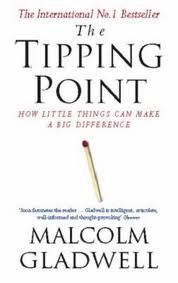The Tipping Point: How Little Things Can Make a Big Difference

– By Malcolm Gladwell
Why is it that certain ideas suddenly – and inexplicably – take off and become the talk of the town? What causes the tipping point? In his best-selling book – The Tipping Point – Malcolm Gladwell explains why.
According to Gladwell, ‘The Tipping Point is the biography of an idea, and the idea is very simple. It is that the best way to understand the emergence of fashion trends, the ebb and flow of crime waves, or, for that matter, the transformation of unknown books into bestsellers, or the rise of teenage smoking, or the phenomena of word of mouth, or any number of the other mysterious changes that mark everyday life is to think of them as epidemics. Ideas and products and messages and behaviors spread just like viruses do.’
Gladwell argues that there are three factors at work at work that spark public interest in an idea:
- The Law of the Few
There are three types of people that help the spread of an idea like an epidemic:
(a) Connectors: Connectors are people who know lots of people. They have that special gift of making large number of friends and acquaintances. Moreover, not only do they know a lot of people, they know a diverse set of people (and not just people associated with their profession, for example).
(b) Mavens: Mavens are people who are very knowledgeable about big and small things. They can tell you which smartphone to buy, which hotel to stay in in Goa (or London or Singapore), which Italian restaurant to visit in Mumbai, where to get the best deal for a can of coffee and so on. Critically, mavens are not just passive collectors of information – they like to share this information aggressively with people they know or those who ask them for help. However, mavens are not necessarily great persuaders – they are the data bank.
(c) Salesmen: The persuaders are the salesmen – they possess immense persuasive power and can sell an idea or a product far more effortlessly than others.
Obviously, if an idea catches the fancy of connectors, mavens and salesmen, it is going to be promoted far and wide. This has an important implication for marketers looking at word-of-mouth promotion for their product or service – they just need to identify a group of connectors, mavens and salesmen and focus on these three rather than a larger set of people.
- The Stickiness Factor: The Law of the Few is just one of the factors for an epidemic to start. The second is the ‘stickiness factor’. Gladwell gives an early example of how Sesame Street succeeded in promoting literacy amongst kids by creating sticky content for television (which was never seen as an effective medium for teaching). The key to stickiness is to make your message memorable and ensure that it motivates people to ACT. However, finding stickiness needs a bit of trial and error and Gladwell gives the example of direct marketers who, through continuous tinkering of their message, are able to come out with messages that motivate consumers to act.
- The Power of Context: The third factor is the Power of Context. Ideas will spread if people spreading the idea are able to build communities around it. As Gladwell writes: “If you want to bring about a fundamental change in people’s belief and behavior, a change that persists and serves as an example to others, you need to create a community around them, where those new beliefs can be practiced and expressed and nurtured.” Another point that Gladwell makes is that sheer numbers are not critical in building an effective community – what is needed is a smaller group with which you have a genuine relationship.
As a marketer, if you are looking at creating an epidemic or a buzz around your brand, you would do well to read The Tipping Point.
Rating: A-
